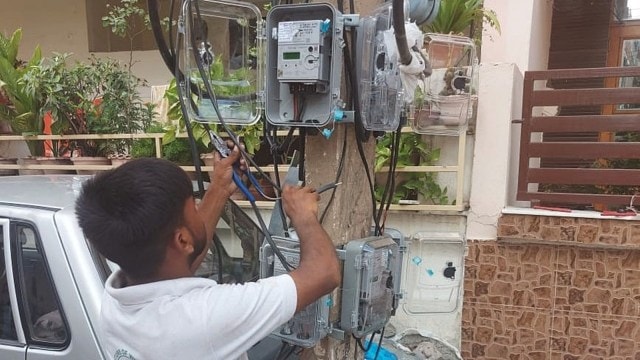
The Maharashtra State Electricity Distribution Company (MSEDCL) has announced the installation of smart meters for all consumers. It says the move will help consumers better plan their usage by allowing them to track their consumption over the month, and also reduce disconnection costs for delinquent consumers. In a separate move, Energy Efficiency Services Ltd, a public sector company, is installing 36 crore smart meters across India, again to improve billing and collection efficiency. These reasons do not cover the key role that smart meters can play in increasing the renewable energy component in today’s energy systems.
While renewable energy has many benefits, a major drawback is the lack of control over generation. For example, the power from solar photovoltaic plants has a steep curve with a maximum at noon and about half that value at 8:30 am and 3:30 pm. Coal generation plants, whose power output can be controlled, will need to be ramped up and down to complement solar power. This makes coal plants inefficient, thus increasing the overall cost of generation, even though solar power itself is relatively cheap. Smart meters can play an important role in alleviating this issue.
In India, consumers largely pay one constant tariff over a period, but the economic cost of electricity varies throughout the day. At any instant, it depends on how well the consumer demand aligns with the generated supply. Broadly, when demand matches supply from low-cost generation sources, the overall cost is low. But if the demand is higher or lower than the supply, the cost increases. This is why, in many states, distribution companies set a lower tariff for the industry at night to encourage usage when demand is expected to be low.
In developed countries, the varying cost of electricity generation is passed on to consumers through an approach called real-time pricing. Smart meters allow continuous information exchange between consumers and suppliers. Consumers take advantage of these varying prices by running appliances like washing machines when the price of electricity is low, say in the middle of the day when solar generation is at a peak. This in turn increases demand in those low-demand periods, leading to a better matching of supply and demand — thus reducing costs for both consumers and distribution companies while maximising renewable energy usage. Knowledge of demand patterns and their time-of-day elasticity helps set up optimal tariffs to encourage such behaviour.
Smart meters can help determine these demand patterns since they can provide easily accessible data on energy usage patterns. A study conducted by the Council on Energy, Environment and Water using smart meter data from homes in Mathura and Bareilly, showed that in the summer, consumers with air conditioners have high consumption at night, while low-demand homes used fans and had constant demand through 24 hours. Such granular data from various types of consumers can be used for better planning.
The Central Electricity Authority conducts an annual Electricity Power Survey, but it is extremely high level. Our study at IIT Bombay has developed a methodology to predict the change in agricultural energy consumption based on changing cropping patterns, a move to micro-irrigation, and other factors. It has been tested extensively in several districts across Maharashtra.
Smart meter data combined with such demand-side models should be used to track consumers’ requirements and trends to predict demand for long-term planning. This is of utmost importance in the electricity sector. Generation plants have lifetimes of more than 25 years and hence, the consequences of building certain plants are felt for a long time. India’s current solar capacity is 63 GW, which is 15 per cent of the total capacity. The central government has set a target of 500 GW, 50 per cent of the projected capacity, by 2030. This is an ambitious target, but let us compare it with Germany, a first-mover in the integration of renewable energy in the grid.
Germany has a solar generation capacity of 30 per cent of the total. 2021 data shows demand is highest in the middle of the day, matching solar generation. This has been made possible because of a sophisticated energy market, and real-time pricing for individual consumers which enables efficient consumption and better integration of renewable sources.
In contrast, the last few years’ data of July 1 for Maharashtra shows largely flat consumption over the day with demand being higher in daytime than at night. However, it is unclear how much is shaped by load scheduling practices such as those followed for agriculture. A study from the National Institute of Advanced Studies (NIAS) shows that Karnataka has peaks at 8 am and 7 pm. Hence, much of the consumption pattern in the country may not follow solar generation. Further, the NIAS study showed that must-run contracts from renewable sources prioritise energy from renewable sources over other cheaper sources, leading to a five per cent to 11 per cent higher energy cost in the Southern states.
India’s distribution companies do not reveal real-time prices to consumers. They purchase energy from generators based on long-term agreements. Merit order dispatch — a system by which the cheapest energy sources are used whenever possible — is not followed either. Yet India aims to increase the solar component to 50 per cent of its total generation capacity by 2030.
India faces two key challenges — how to protect the bottom 80 per cent whose energy consumption is abysmally low, and how to reduce tariffs for industry which are extremely high, by global standards. Informed tariff setting that can shape demand to match supply, and thus allow better integration of low-cost renewables, is the way ahead. For this, a closer partnership between academia and the electricity sector must be fostered.
The writer is a professor at the Centre for Technology Alternatives for Rural Areas, IIT Bombay